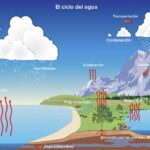We explain how climate and weather differ. Also, what are the elements of climate and the factors that affect it.

What is the difference between climate and meteorological weather?
We often use the terms climate and weather or meteorological weather in everyday life as if they were synonyms, when in reality they are two very different concepts.
Climate is the set of meteorological conditions that characterize a place determined of the planet, that is, it is the normal meteorological trend of a specific place. Instead, weather refers to the particular state of the atmosphere (actually the troposphere, its lowest layer) at a certain place and time.
In other words, time refers to the momentary, short-lived state of the atmosphere at a location. It is expressed in manifestations such as rain, cold or heat, wind or any other atmospheric phenomenon. The weather is what is normally checked before leaving home, by tuning into the weather station on the radio or television, or through computer applications designed for this purpose.
Instead, climate is the general or normal trend of weather in that location, and is determined through long-term measurements and statistics. This is because the climate of a region does not change from one day to the next (as the weather does), but rather it is a continuous meteorological panorama.
Thus, it is possible to organize the planetary geography according to climatic patterns, that is, to the well-differentiated types of climate that are observed in the different regions of the Earth: the humid subtropical climate, the temperate climate or the Mediterranean climate, to name a few. just some examples.
In short, the weather in a place refers to what the atmosphere is like at that moment; while the climate of a place refers to how the atmosphere usually is at different times of the year.
See also: Climatology
Elements of climate
The climate of a region is made up of different elements, that is, values that are recorded throughout the year to understand its patterns and the impact this has on the perception of the atmosphere by human beings. These elements are:
- atmospheric temperature. It is the degree of heat (that is, energy) that is in the atmosphere at a given time and place. This largely depends on the amount of solar radiation and the perpendicularity of the solar rays, since the greater the incidence of solar radiation, the hotter the atmosphere will become.
- atmospheric pressure. This is the force that the atmosphere exerts on the Earth's surface, that is, its weight: an atmosphere loaded with water vapor and raindrops weighs much more than a clear atmosphere, for example. However, pressure can also vary according to altitude: the higher up we are, the less pressure we will feel.
- the wind. This is the movement of air masses as a result of local variations in atmospheric pressure. When air masses move, we perceive them as wind, and in doing so they usually have a significant effect on the distribution of energy in the atmosphere.
- humidity. This is the amount of water vapor present in the atmosphere, which is directly linked to the hydrological cycle, but also to the topographic and hydric conditions of the place. Places near large bodies of water (lakes, seas, rivers) are wetter, while desert places or plains in the middle of continents tend to be drier.
- The precipitation. It is about the amount, frequency and volume of rain in a given place and time. It also includes other forms of precipitation, such as snow and hail, which occur depending on the temperature, pressure, and humidity conditions in the atmosphere.
Climate factors
Climate factors are the aspects that determine the climate of a place, that is, the conditions and variables that decide whether said place has one or another type of climate. These factors are:
- The altitude of the place. It refers to the height at which a place is located, whether at sea level or on top of a mountain. At higher altitudes, the atmosphere has lower temperatures, higher solar radiation and lower atmospheric pressure, and these elements allow clearly differentiated thermal “steps” to be identified.
- The latitude of the place. It refers to the geographical location of the place with respect to the central planetary axis, which is the equator. Places far from the latter tend to have more extreme climates, with lower solar incidence and clearly differentiated seasons, while regions close to the equator lack seasons and have warmer and more regular climates.
- The distance from the sea. It refers to the proximity or distance of a site from the sea or any other large body of water. Places close to the sea have higher atmospheric humidity and therefore more stable climates, while places far away tend to be dry and have more extreme climates.
- The orientation of the relief. It refers to the location of a place in its geography, that is, to the way in which it is located on the earth's surface. Depending on whether you are in a valley, on a mountainside, or on the coast, the climate will be shaped by the topography.
- ocean currents. It refers to the continuous movement of the large masses of water in the oceans, which have different degrees of temperature and, therefore, different margins of impact on the climate. As water moves, it transmits or retains energy from the atmosphere, causing changes in wind patterns and ambient humidity. Of particular importance are the Gulf Stream, which brings warm water to the intertropical coasts of Europe; or the Labrador Current, which carries cold water from the pole to the northern Atlantic Ocean.
- The direction of planetary and stationary winds. It refers to the movement of large masses of air in the atmosphere, which circulate from one region to the other continuously and permanently, or during specific times of the year. As with ocean currents, the flow of winds has an important impact on the distribution of energy in the atmosphere and the production of atmospheric phenomena. For example, in the East many countries have a clearly recognizable monsoon wind season, which brings torrential rains and a general cooling of the climate.
Instruments for measuring meteorological weather

While the study of climate is undertaken at geographical levels, through the study of its triggering factors, the study of weather is carried out in a practical and immediate manner, through the use of different scientific instruments, such as:
- The environmental thermometer. It is a device equipped with a heat-sensitive termination, not very different from the one we use to measure body temperature, which is used to record the temperature of the atmosphere. At higher temperatures, the sensitive material expands and in its movement it registers the degrees of heat thanks to a scale printed on the device.
- The barometer. It is a device capable of measuring atmospheric pressure, using a column of liquid (formerly, mercury, but today it can be water) on which the weight of the atmosphere affects, making it move towards a larger container. Thus, by measuring the displacement of the liquid inside the container, the amount of force that the atmosphere exerts on it can be calculated.
- The anemometer. It is a device equipped with a pinwheel or mobile device, sensitive to the thrust of the wind, and which, when rotating on its axis, measures the force and speed with which the air mass moves. In other words, it is used to measure the intensity and speed with which the wind blows.
- The rain gauge. It is a cylindrical device with an initial opening that allows collecting and measuring the volume of precipitation in a given place and for a certain time. The water sample taken by the device is measured (using a graduated ruler or the weight of the water itself) to obtain a projection of the amount of rain fallen.
- The weather vane. It is an artifact that rotates on its own axis as the movement of the wind exerts force on it, and that has a pointer very similar to that of a compass, to indicate the direction in which the wind blows with respect to the four cardinal points.
Continue with: Meteorology
References
- “Climate” on Wikipedia.
- “Weather” in Wikipedia.
- “Weather and climate” on Wikipedia.
- “Differences between climate and meteorological time” on Univisión.
- “Difference between time and climate” in Meteorology and Climatology of Navarra (Spain).





